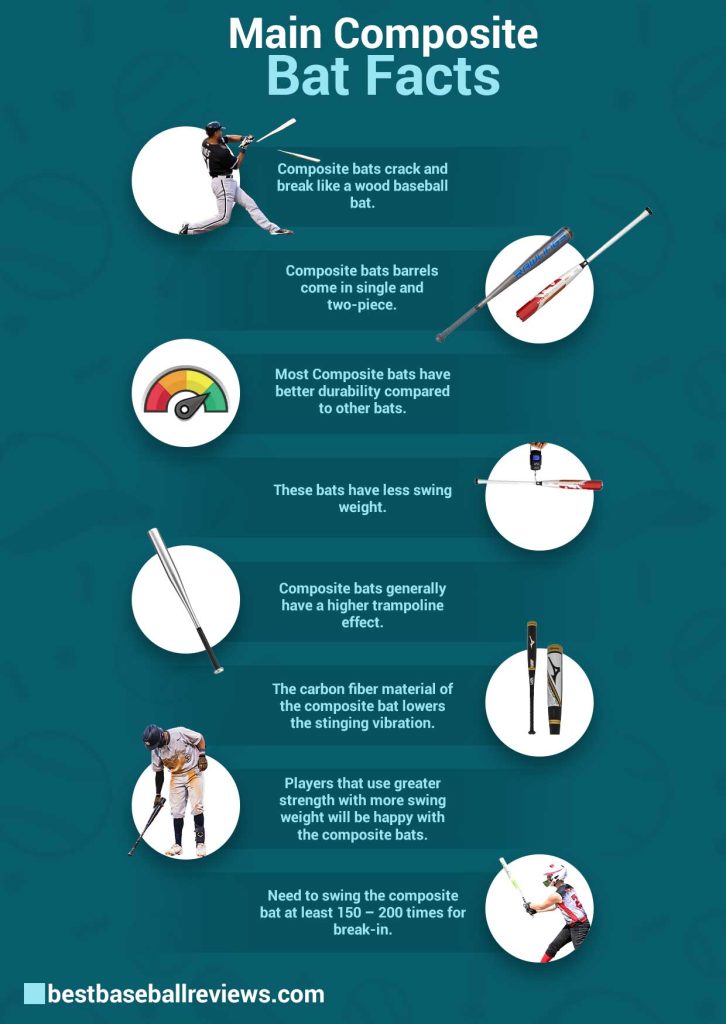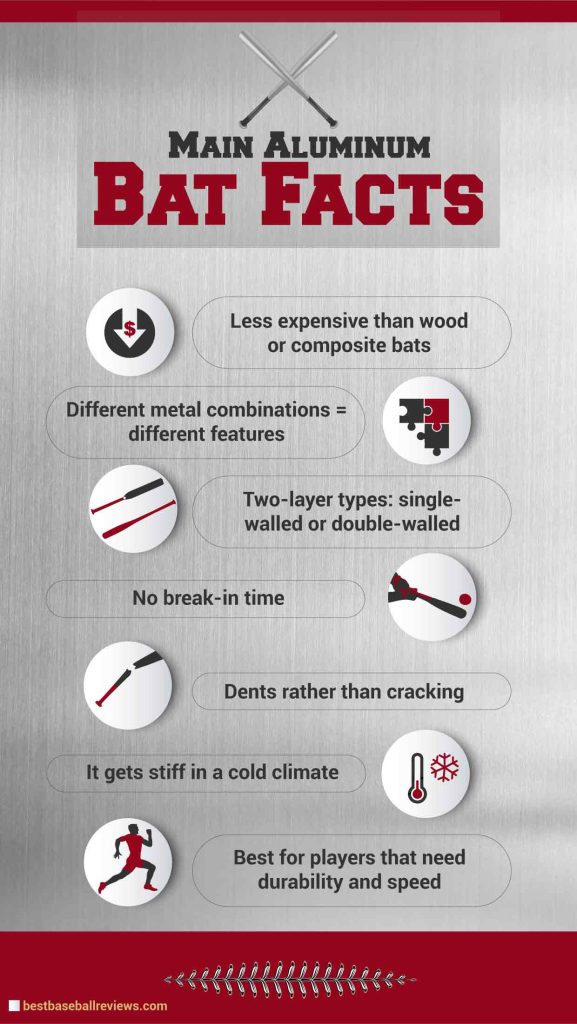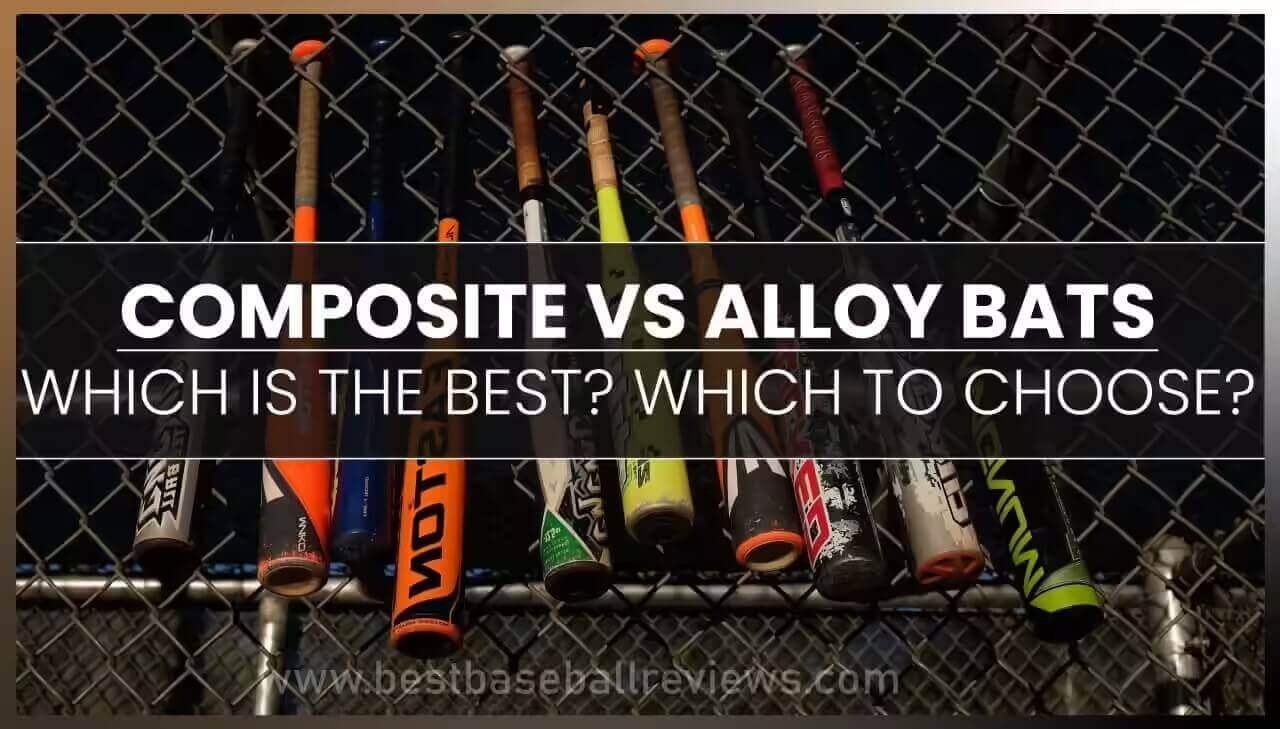This has been debated for a long time. But composite vs alloy bats, which is the best or which one you should choose, is still ongoing. If you are somewhat like me, then you also have a hard time deciding.
Currently, the main types of baseball bats are wood, alloy, or composite in the market. Out of these, composite and alloy bats are the most popular ones. Therefore, we will do a deep dive into composite and alloy bats for your benefit.
In each section, I will explain the difference between composite and alloy bats and their pros and cons.
Finally, I will also give our take on which is the best between composite and alloy.
Table of Contents
Composite Bats:

Before we talk about composite bats, I need to ask you if you have heard about hybrid bats. If it’s yes, you should know that there is a difference between the two. For those that don’t know about hybrid bats, it’s ok if you don’t.
The main characteristic of a composite bat is that it’s made from a composite material. These composite materials are carbon fibers since carbon materials or fiber polymer are the main components.
Alongside those, other materials like fiberglass and graphite are in use. All of these materials are layered for the best results.
Using these “carbon fibers,” manufacturers can add multiple useful features or functions to make the composite bats desirable. Common features or functions can be better weight distribution, more pop, or a larger sweet spot.
Also, composite bats can come as a single-piece bat, meaning both the barrel and the handle come from a single piece of “carbon fiber.” Or it can come as a two-piece composite bat where the barrel and handle are of different composite material mended in some manner.
What are the benefits of composite baseball bats?

More “POP”:
The biggest benefit of composite bats is how much pop youth players can achieve. In addition, composite bats have a larger sweet spot than wood or alloy bats so that you can get a baseball further.
Batters can hit further faster thanks to the fiber polymers used in composite bats. In the composite vs alloy bats competition, you will see that composite bats make the baseball fly off the barrel faster with extra fast.
These baseball bats feature the trampoline effect, which is most prominent in composite bats.
Less Sting:
Coupled with more pop, composite bat’s benefits are that the carbon fiber body reduces the amount of sting a batter will feel. Composite bats do this by deflecting or controlling the stinging vibration away from the batter’s hand.
If you are a batter, you should know how bad the sting is when you miss a baseball. Thankfully, I don’t get to bat as much as a catcher, but some of my hitter friends have told me some horror stories.
Between the single-piece and two-piece composite bats, the two-piece is the best in absorbing the electric jolts. In fact, composite bat handles are so good at absorbing impacts that many makers are not making a hybrid option that includes composite bat handles.
Better Balance:
In composite vs alloy bats, the composite bats are best for providing batters with a more balanced swing. Swing weight is the weight going through the bat as the hitter contacts the baseball.
Due to composite bats having plastic properties, it stretches their material more evenly around the barrel. Thus the batters can transfer more of their weight during an at-bat.
Lighter than Alloy:
Between composite and alloy bats, the composite baseball bats are lighter. The composite bats are generally lighter while maintaining their length/weight ratio.
Composite bats use carbon fiber and other fiber polymer materials, which are generally lighter than other bats.
What are the cons of composite bats?
Can be Expensive
Due to its rising popularity, a composite bat can be somewhat expensive. In fact, certain brands’ composite bats can run up to a few hundred dollars, including shipping fees.
The composite bats are more likely to outperform alloy bats than composite and alloy bats. Composite bats surpass alloy bats in performance and design as well.
In my experience, I have seen that composite and alloy performance are neck in neck in the hands of youth baseball batters.
Cold Weather Bad for Composite Bats
In cold weather climates, a composite bat is prone to breakage. However, a composite bat doesn’t break like an alloy bat. Instead, when it breaks, you will see vertical cracks along the length of its barrel, much like wood bats.

Main Composite Bat Facts

Alloy Bats:

Alloy bats aren’t allowed in some higher leagues, such as MLB, but other smaller leagues do. Most alloy bats use metal alloys such as aluminum alloy. Their production started in the 1970s.
These alloys layered in sheets layered on top of each other for the best results. Also, the makeup of the alloy consists of two or more metals with varying properties alongside aluminum.
These different properties allow manufacturers of aluminum alloy bats to give their bats different characteristics.
Some of the best wooden baseball bats are seen in the higher leagues. But the youth baseball dugouts are filled with alloy bats once they level up from tee-ball bats or Whiffle ball bats.
Even though coaches will use the best fungo bats while teaching, they sometimes use alloy bats.
What are the benefits of alloy bats?

Higher Durability
The biggest benefit of aluminum bats is that they last for a really long time. Due to the metal alloys’ quality and the layering process, aluminum bats can last longer than composite or wood bats.
With composite bats, you might wonder how long it lasts, but you don’t need to with these bats.
With longer durability, young and pro batters can perform better when they use a single bat.
Loud “Ping”
Like the POP you get from a composite bat, the alloy bats produce a more pinging sound. This, to me, is the most well-known aspect of aluminum bats that I heard while training and coaching youth leagues.
The harder a player could hit the baseball, I saw that the louder the pinging sound was. In fact, many of the youth players I coached measured the success of their hits based on how loud of a ping they could make.
Also, the ping sound is most audible when you hit the sweet spots in alloy bats. So it serves as a guide for young players.
A Cheaper Option
You might think it, but I say that an alloy bat is cheaper compared to wood and composite bats. This might surprise you because many think that metal is more expensive; thus, metal bats will be more expensive.
As I have said above, a composite is made to be better in every part compared to alloy and wood bat. However, in the hands of a skilled batter, a cheaper metal bat will perform all most the same as the more costly composite bat.
No Break-In Time
As a catcher, I know a thing or two about how to break in a baseball glove, but to my surprise, bats also need break-in. Lucky for you, I know that alloy bats don’t need any break-in at all.
What are the cons of alloy baseball bats?
Dents
Unlike a wooden bat or composite bat, a metal bat doesn’t crack since it’s metal. But it does dent when it’s used to hit a baseball repeatedly. Sometimes a player might even be given a “lemon” bat with some dents.
In that case, I say to check if the manufacturer has a warranty. If yes, get another one for free if not, then replace it with another.
This is because all youth leagues ban damaged bats due to the possibility of them causing injuries.
No Good in Cold Weather
Due to the colder temperatures, a metal bat might become stiffer than the norm. If that happens, the bat might not handle the force from hits.
From what I heard, the cold weather causes the internal structure of the bat to change so that it’s denser and heavier.
Main Aluminum Bat Facts

Hybrid Bats:
Other than a composite baseball bat or alloy bat, baseball players can also use a hybrid bat. The reason it’s called a hybrid baseball bat is because it contains parts from both composite and aluminum bats.
These hybrid baseball bats have benefited from both types of bats. For example:
- It has a composite handle and alloy barrel
- Cheaper than composite bats but expensive than aluminum bats
- It takes about an hour to break-in
- More durable than composite bats
At the same time, hybrid bats share some disadvantages. For example:
- Not allowed in many league matches
- Best for training or recreational games only
- Hard to get used to for some
- Cold weather is bad for the metal barrels
Composite vs Alloy Bats: Which should you pick?

In composite vs alloy bats, there is much that is different. But, as I said above, each has its strengths and weaknesses. So when it comes to choosing them, you need to think about what you need.
For example, if you are a contact hitter for a youth league since MLB only allows wooden bats, you need just to make contact. For that purpose, I recommend getting a composite bat.
Since composite bats are well balanced, allow for much speed, and have a higher trampoline effect.
On the other hand, an end-loaded metal bat is a way to go for a power hitter who has the strength to spare and needs something that can take a beating.
Which Do I Pick?
Personally speaking, as a catcher, I rarely went to the batter’s plate, but the few times I did, wood or composite bats tend to be my choice.
Since I knew that I couldn’t get a baseball out of the field, the best I could do was get the ball in play. For that, I needed something consistent and didn’t need a lot of speed and power to rip a ball.
Conclusion
There aren’t many similarities or differences between aluminum and wood bats or composite vs aluminum bats. This is because those bats are unique in their own way, and how you play with them will be very different.
Yet, I tried my best to explain the usefulness and problems between aluminum and composite bats as well as I could.
Hopefully, if you are a youth baseball batter now, you will know which you should go the next time you step onto the plate.



